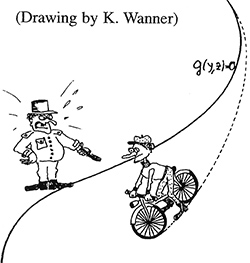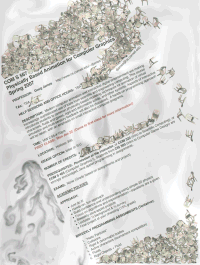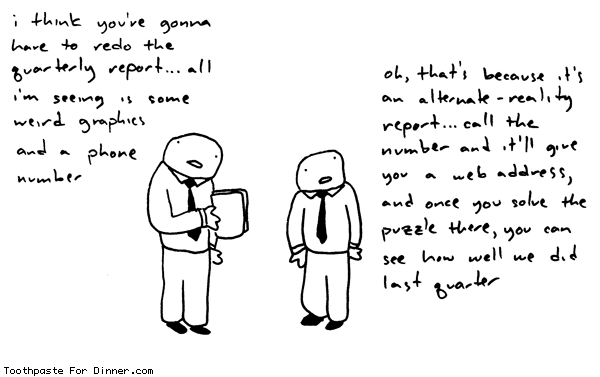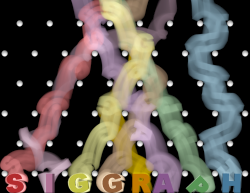- David Baraff and Andrew Witkin, Physically Based Modeling, Online SIGGRAPH 2001 Course Notes, 2001.
- An interesting historical perspective:
- Terzopoulos, D., Platt, J., Barr, A., Zeltzer, D.,
Witkin, A., and Blinn, J. 1989. Physically
based modeling: past, present, and future. In
ACM SIGGRAPH 89
Panel Proceedings (Boston, Massachusetts,
United States, July 31 - August 04, 1989). SIGGRAPH
'89. ACM Press, New York, NY, 191-209.

- David Baraff and Andrew Witkin, Physically Based Modeling, Online SIGGRAPH 2001 Course Notes, 2001.
- Differential Equation Basics
- Particle
System Dynamics
- Cloth and Fur Energy Functions (preview of energy function usage)
- Videos:
- Particle Dreams
by Karl Sims, 1988.

- constant, c
- position, p_j
- vectors, (p_j-p_k)
- distances, ||p_j-p_k||
- distance powers, ||p_j-p_k||^n
- functions of distance, W(||p_j-p_k||)
- dot products, (p_1-p_0)^T (p_3-p_2)
- cross products
- Example: hair bending energy derivative, E = k*sin^2(theta/2) [handout]
- Numerical
differentiation (less appealing in higher
dimensions)
- Automatic and symbolic differentiation (Wiki)
- A
local Mitsuba
autodiff implementation
- Symbolic
derivatives with optimized codegen (Maple)
- Slides
- Timothy Langlois's writeup on Automatic Differentiation of Moving Least Squares [Code example]
- Other examples
ThFeb05

- Holonomic constraints, C(p)=0.
- Example: Bead on a wire
- Differentiating constraints w.r.t. time.
- Constraint Jacobian, J
- Lagrange multipliers, lambda, and constraint forces,
J^T lambda
- Solving for Lagrange multipliers
- (Implicit constraint (and half-explicit) DAE integration schemes)
- Post-step projection schemes
- Position- vs velocity-based corrections
- Applications: Mechanical linkages, inextensibility constraints, incompressible flow, contact constraints
- David Baraff and Andrew Witkin, Physically Based Modeling, Online SIGGRAPH 2001 Course Notes, 2001.
- Examples from Cloth Simulation:
- Rony Goldenthal, David Harmon, Raanan Fattal, Michel Bercovier, Eitan Grinspun, Efficient Simulation of Inextensible Cloth, ACM Transactions on Graphics, 26(3), July 2007, pp. 49:1-49:7. [ACM Digital Library link]
- Jonathan M. Kaldor, Doug L. James, Steve Marschner, Simulating Knitted Cloth at the Yarn Level, ACM Transactions on Graphics, 27(3), August 2008, pp. 65:1-65:9.
- U.M. Ascher and L.R. Petzold, Computer Methods for Ordinary Differential Equations and Differential-Algebraic Equations, SIAM.
- E. Hairer and G. Wanner, Solving Ordinary Differential Equations II: Stiff and Differential-Algebraic Problems, 2nd edition, Springer, 1996. (See Chapter VII.(1-2) Differential-Algebraic Equations of Higher Index)
ThFeb12
![GPU-accelerated SPH [Harada et al.
2007]](images/thumb_HaradaGPUSPH.jpg)

- Smoothed Particle Hydrodynamics (SPH)
- Matthias M�ller, David Charypar, Markus Gross, Particle-based fluid simulation for interactive applications, 2003 ACM SIGGRAPH / Eurographics Symposium on Computer Animation (SCA 2003), August 2003, pp. 154-159. [Video]
- Miles Macklin and Matthias M�ller. Position Based Fluids. ACM Trans. Graph. 32, 4, Article 104 (July 2013), 12 pages. (other videos)
- Liu, G. Gui-Rong, and M. B. Liu. Smoothed
particle hydrodynamics: a meshfree particle
method. World Scientific,
2003.
- Wikipedia
- Takahiro Harada, Seiichi Koshizuka, Yoichiro Kawaguchi, Smoothed Particle Hydrodynamics on GPUs, Computer Graphics International, pp. 63-70, 2007.
- B. Solenthaler, R. Pajarola, Predictive-Corrective Incompressible SPH, ACM Transactions on Graphics, 28(3), July 2009, pp. 40:1-40:6. [PDF] [YouTube Video]
- SIGGRAPH fluids course: [SPH
pages (pp. 83-86)]
- Bridson, R., Fedkiw, R., and Muller-Fischer, M. 2006. Fluid simulation: SIGGRAPH 2006 course notes, In ACM SIGGRAPH 2006 Courses (Boston, Massachusetts, July 30 - August 03, 2006). SIGGRAPH '06. ACM Press, New York, NY, 1-87. [Slides, Notes]
- Robert
Bridson, Fluid Simulation for
Computer Graphics, A K Peters, 2008.
[Book format]
- Granular materials:
- ../2014sp/images/thumb_symplecticEuler.jpgNathan Bell, Yizhou Yu, and Peter J. Mucha, Particle-Based Simulation of Granular Materials, ACM SIGGRAPH/ Eurographics Symposium on Computer Animation 2005, [PDF] [Video]
- Coupling SPH and rigid-body simulations (advanced):
- N. Akinci, M. Ihmsen, G. Akinci, B. Solenthaler, M.
Teschner, Versatile
Rigid-Fluid Coupling for Incompressible SPH,
ACM Trans. Graph. (SIGGRAPH Proc.), 2012. [PDF]
[AVI]
- Isosurface extraction
- Rendering
Position Based Fluids
Project webpage. Starter code is on CMS.

- Forward Euler
- Backward Euler
- Symplectic Euler (a.k.a. semi-implicit Euler); symplectic Euler adjoint
- E. Hairer, C. Lubich, and G. Wanner. Geometric Numerical Integration. Structure-Preserving Algorithms for Ordinary Differential Equations., Springer Series in Comput. Mathematics, Springer-Verlag, volume 31, 2002.
- Midpoint
method
- Verlet method (a.k.a. St�rmer's method)
- Stability analysis of forward & backward Euler schemes on test problem
ThFeb26
IMEX and other schemes
![Cloth from [Baraff & Witkin
1998]](../2014sp/images/thumb_BW98.jpg)
- Blackboard
- David Baraff and Andrew Witkin, Physically Based Modeling, Online SIGGRAPH 2001 Course Notes, 2001.
- Implicit Methods (Baraff)
- David
Baraff, Andrew P. Witkin, Large
Steps
in
Cloth Simulation, Proceedings of SIGGRAPH
98, Computer Graphics Proceedings, Annual Conference
Series, July 1998, pp. 43-54.
- Implicit-Explicit (IMEX) integration schemes:
- Ascher, Ruuth, Wetton, Implicit-Explicit Methods for Time-Dependent Partial Differential Equations, SIAM J. Num. Anal. 32, pp. 797-823, 1995.
- Bernhard Eberhardt, Olaf Etzmu�, Michael Hauth, Implicit-Explicit Schemes for Fast Animation with Particle Systems, Computer Animation and Simulation 2000, Proceedings of the EG Workshop in Interlaken, 21-22 August, 2000.
- Example: "Going implicit on damping"
TuMar03
ThMar05
and other relaxation-based dynamics
![From Nucleus [Stam
2009]](http://www.autodeskresearch.com/img/publications/thumb_pub_nucleus.jpg)
- M. M�ller, B. Heidelberger, M. Hennix, J. Ratcliff, Position Based Dynamics, Proceedings of Virtual Reality Interactions and Physical Simulations (VRIPhys), pp 71-80, Madrid, November 6-7 2006, Best Paper Award, PDF, (video), (slides)
- Jos Stam, Nucleus:
Towards a Unified Dynamics Solver for Computer
Graphics, 2009 Conference Proceedings: IEEE
International Conference on Computer-Aided Design and
Computer Graphics, pp. 1-11, 2009. (related talk)
- T. Jakobsen, Advanced Character Physics, Game Developer Conference, 2001.
- Miles Macklin, Matthias M�ller, Nuttapong Chentanez,
and Tae-Yong Kim. 2014. Unified
particle physics for real-time applications.
ACM Trans. Graph. 33, 4, Article 153 (July 2014), 12
pages. [ACM
link]
- Sofien Bouaziz, Sebastian Martin, Tiantian Liu,
Ladislav Kavan, and Mark Pauly. 2014. Projective
dynamics: fusing constraint projections for fast
simulation. ACM Trans. Graph. 33, 4, Article
154 (July 2014), 11 pages. [ACM
link]
Position Based Dynamics
TuMar10
![Cloth from [Bridson et al. 2002]](../2014sp/images/thumb_bridson02.jpg)
- Motivation: cloth and hair animation
- Continuous collision detection
- 2D/3D sphere-sphere, 2D (point-edge), and 3D (point-face, edge-edge) tests
- Velocity-level collision resolution; collision impulses
- Supporting pin/trajectory constraints
- Inverse-mass-matrix
filtering
- Penalty forces
- Rigid cloth zones
- Untangling
cloth
- Cloth related:
- Robert Bridson, Ronald P. Fedkiw, John Anderson, Robust Treatment of Collisions, Contact, and Friction for Cloth Animation, ACM Transactions on Graphics, 21(3), July 2002, pp. 594-603
- A. Selle, J. Su, G. Irving, and R. Fedkiw, Robust High-Resolution Cloth Using Parallelism, History-Based Collisions and Accurate Friction, IEEE Transactions on Visualization and Graphics (TVCG), 15(2), 339-350.
- T. Brochu,
E. Edwards, and R. Bridson, Efficient
Geometrically Exact Continuous Collision
Detection, Proc. SIGGRAPH 2012. (open-source
code, project)
(method to avoid the nonrobustness
of "cubic solver approach" for 3D cloth)
- Robust Treatment of Simultaneous Collisions, David Harmon, Etienne Vouga, Rasmus Tamstorf, Eitan Grinspun, ACM Transactions on Graphics, 27(3), August 2008, pp. 23:1-23:4. (equality-constraint alternative to rigid cloth zones)
- X. Provot, Collision and self-collision handling in cloth model dedicated to design garment. Graphics Interface, 177�89, 1997. (first introduction of rigid cloth zones)
- General collision detection:
- M. Lin and S. Gottschalk, Collision detection between geometric models: A survey, Proc. of IMA Conference on Mathematics of Surfaces, volume 1, pp. 602-608, 1998.
- P. Jimenez, F. Thomas, and C. Torras, 3D collision detection: A survey, Computers & Graphics, Elsevier, 25(2), pp. 269-285, 2001.
- Gino Van Den Bergen, Efficient collision detection of complex deformable models using AABB trees, Journal of Graphics Tools, 1998
- Untangling cloth interpenetrations:
- David Baraff, Andrew Witkin, and Michael Kass. 2003. Untangling Cloth. ACM Trans. Graph. 22, 3 (July 2003), 862-870.
-
Pascal
Volino , Nadia Magnenat-Thalmann, Resolving
surface collisions through intersection contour
minimization, ACM Transactions on
Graphics (TOG), v.25 n.3, July 2006
ThMar19
![Rigid bodies in contact [Baraff notes]](images/thumb_rigidbody.png)
- Rigid body
dynamics
- Position, orientation, linear/angular velocity, momentum, inertia, equations of motion, etc.
- Euler's
equations of angular rigid-body dynamics (in
body coordinates)
- Contact impulses
- Example:
"rigid damping"
- Frictionless contacts:
- Nonpenetration constraints
- Velocity-level
constraints (see Baraff course notes for
acceleration-level constraints)
- Linear
Complementarity Problem (LCP)
- David Baraff and Andrew Witkin, Physically Based Modeling, Online SIGGRAPH 2001 Course Notes, 2001.
- (see cloth references for rigid cloth zones)
TuMar17
Guest Lecturer: Tim Langlois
![From [James et al. 2006]](http://www.cs.cornell.edu/%7Edjames/research/pics/PAT.gif)
- Modal sound synthesis
- Precomputed acoustic transfer
- Precomputed
acceleration noise
- Compression techniques
- K. van den
Doel and D. K. Pai, The
Sounds of Physical Shapes, Presence:
Teleoperators and Virtual Environments, 7:4, The MIT
Press, 1998. pp. 382--395.
- Kees van den
Doel, Paul G. Kry, Dinesh K. Pai, FoleyAutomatic:
Physically-Based Sound Effects for Interactive
Simulation and Animation, Proceedings of ACM
SIGGRAPH 2001, Computer Graphics Proceedings, Annual
Conference Series, August 2001, pp. 537-544. [Video]
- Dinesh K.
Pai, Kees van den Doel, Doug L. James, Jochen Lang,
John E. Lloyd, Joshua L. Richmond, Som H. Yau, Scanning
Physical Interaction Behavior of 3D Objects,
Proceedings of ACM SIGGRAPH 2001, Computer Graphics
Proceedings, Annual Conference Series, August 2001,
pp. 87-96. [Video]
- James F. O'Brien, Perry R. Cook, Georg Essl, Synthesizing Sounds From Physically Based Motion, Proceedings of ACM SIGGRAPH 2001, Computer Graphics Proceedings, Annual Conference Series, August 2001, pp. 529-536.
- Perry R. Cook, Sound Production and Modeling, IEEE Computer Graphics & Applications, 22(4), July-August 2002, pp. 23-27.
- James F. O'Brien, Chen Shen, and Christine M. Gatchalian. Synthesizing sounds from rigid-body simulations. In The ACM SIGGRAPH 2002 Symposium on Computer Animation, pages 175�181. ACM Press, July 2002.
- Doug L.
James, Jernej Barbić and Dinesh K. Pai, Precomputed
Acoustic Transfer: Output-sensitive, accurate sound
generation for geometrically complex vibration
sources, ACM Transactions on Graphics, 25(3),
pp. 987-995, July 2006, pp. 987-995.
- Changxi Zheng and Doug L. James, Rigid-Body Fracture Sound with Precomputed Soundbanks, ACM Transactions on Graphics (SIGGRAPH 2010), 29(3), July 2010, pp. 69:1-69:13.
- Changxi Zheng and Doug L. James, Precomputed Acceleration Noise for Improved Rigid-Body Sound, ACM Transactions on Graphics, August 2012.
- Steven S. An , Doug L. James, and Steve Marschner, Motion-driven Concatenative Synthesis of Cloth Sounds, ACM Transactions on Graphics, August 2012.
- Timothy
R. Langlois, Steven S. An, Kelvin K. Jin, and
Doug L. James. Eigenmode
Compression for Modal Sound Models. ACM
Transactions on Graphics (SIGGRAPH 2014). 33(4),
August, 2014.
...
Impulse- and Constraint-based Methods


- General discussion of contact methods, with specific discussions of typical impulse-based [Guendelman et al. 2003] and constraint-based [Erleben et al. 2007] solvers.
- Excellent recent review:
- Jan
Bender, Kenny Erleben and Jeff Trinkle, Interactive
Simulation of Rigid Body Dynamics in Computer
Graphics, Computer Graphics Forum,
Volume 33, Issue 1, pages 246�270, February 2014,
DOI: 10.1111/cgf.12272.
- Impulse-based
contact
solvers:
- Brian Mirtich,
John Canny, Impulse-based
Simulation of Rigid Bodies, 1995
Symposium on Interactive 3D Graphics, April 1995,
pp. 181-188.
- Eran Guendelman, Robert Bridson, Ronald P. Fedkiw, Nonconvex Rigid Bodies With Stacking, ACM Transactions on Graphics, 22(3), July 2003, pp. 871-878. [an iterative impulse-based solver]
- Projected Gauss-Seidel solver:
- K.
Erleben, Stable,
robust,
and
versatile multibody dynamics animation. Ph.D.
thesis, Department of Computer Science, University
of Copenhagen, Denmark, 2005. [avi movie]
- K. Erleben, Velocity-based shock propagation for multibody dynamics animation, ACM Trans. Graph. 26, 2, Jun. 2007.
- Projected Jacobi solver:
- Richard
Tonge, Feodor Benevolenski, Andrey Voroshilov, Mass
Splitting for Jitter-Free Parallel Rigid Body
Simulation, ACM Trans. Graphics
(SIGGRAPH 2012), 31(4), 2012.
- SIAM Review of rigid-body contact:
- D.E. Stewart, Rigid-body dynamics with friction and impact, SIAM Review, volume 42, 2000.
- "Staggered Projections" method:
- Danny M. Kaufman, Shinjiro Sueda, Doug L. James, Dinesh K. Pai, Staggered Projections for Frictional Contact in Multibody Systems, ACM Transactions on Graphics, 27(5), December 2008, pp. 164:1-164:11.
- A good reference on convex optimization:
- Stephen Boyd and Lieven Vandenberghe, Convex Optimization, Cambridge University Press, 2004.
- Stanford lecture notes/book [PDF]

- Project proposal (PDF format) [DUE: Thursday, April 10, 2015]

- No lecture.
- Prof James away--chairing SIGGRAPH 2015 Technical Papers committee meeting in Chicago.
ThApr09

- Jos Stam, Stable Fluids, Proceedings of SIGGRAPH 99, Computer Graphics Proceedings, Annual Conference Series, August 1999, pp. 121-128. [Slides and notes]
- Ronald Fedkiw, Jos Stam, Henrik Wann Jensen, Visual Simulation of Smoke, Proceedings of ACM SIGGRAPH 2001, Computer Graphics Proceedings, Annual Conference Series, August 2001, pp. 15-22. (introduces vorticity confinement forces)
- Bridson, R., Fedkiw, R., and Muller-Fischer, M. 2006. Fluid simulation: SIGGRAPH 2006 course notes, In ACM SIGGRAPH 2006 Courses (Boston, Massachusetts, July 30 - August 03, 2006). SIGGRAPH '06. ACM Press, New York, NY, 1-87. [Slides, Notes]
- Robert Bridson, Fluid Simulation for Computer Graphics, A K Peters, 2008:

- Jonathan Richard Shewchuk, An Introduction to the Conjugate Gradient Method Without the Agonizing Pain, August 1994. PDF (516k, 58 pages)
- G.H. Golub and C.F. Van Loan, Matrix Computations, 4th Edition, Johns Hopkins University Press, 2013.

- Matthias
M�ller, Bruno Heidelberger, Matthias Teschner, Markus
Gross, Meshless
deformations based on shape matching, ACM
Transactions on Graphics, 24(3), August 2005, pp.
471-478. [ACM]
[PDF] [AVI]
- Alec R. Rivers, Doug L. James, FastLSM: Fast Lattice Shape Matching for Robust Real-Time Deformation, ACM Transactions on Graphics, 26(3), July 2007, pp. 82:1-82:6. [ACM] [PDF]
- Denis Steinemann, Miguel A. Otaduy, Markus Gross, Fast Adaptive Shape Matching Deformations, ACM SIGGRAPH/Eurographics Symposium on Computer Animation, Dublin, July 7-9, 2008. [PDF] [AVI]
- Matthias M�ller and Nuttapong Chentanez. Solid simulation with oriented particles. ACM Trans. Graph. 30, 4, Article 92 (July 2011), 10 pages, 2011. [ACM] [PDF] [MOVIE]
Material:
- Demetri
Terzopoulos, Kurt Fleischer, Modeling
Inelastic Deformation: Viscoelasticity,
Plasticity, Fracture,Computer Graphics
(Proceedings of SIGGRAPH 88), August 1988, pp.
269-278.
- James F. O'Brien, Jessica K. Hodgins, Graphical Modeling and Animation of Brittle Fracture, Proceedings of SIGGRAPH 99, Computer Graphics Proceedings, Annual Conference Series, August 1999, pp. 137-146.
- James F. O'Brien, Adam W. Bargteil, Jessica K. Hodgins, Graphical Modeling and Animation of Ductile Fracture, ACM Transactions on Graphics, 21(3), July 2002, pp. 291-294.
- Neil Molino,
Zhaosheng Bao, Ron Fedkiw, A
virtual node algorithm for changing mesh topology
during simulation, ACM
Transactions on Graphics, 23(3), August 2004,
pp. 385-392.
- M. M�ller,
M. Gross, Interactive
Virtual Materials, in
Proceedings of Graphics Interface (GI 2004), pp
239-246, London, Ontario, Canada, May 17-19, 2004. (Video)
- Mark Pauly,
Richard Keiser, Bart Adams, Philip Dutr�, Markus
Gross, Leonidas J. Guibas, Meshless
animation of fracturing solids, ACM
Transactions on Graphics, 24(3), August 2005,
pp. 957-964. [ACM]
(Video)
[PDF]
- Hayley N. Iben, James F. O'Brien, Generating Surface Crack Patterns, 2006 ACM SIGGRAPH / Eurographics Symposium on Computer Animation, September 2006, pp. 177-186.
- Denis
Steinemann, Miguel A. Otaduy, Markus Gross, Fast
Arbitrary Splitting of Deforming Objects, 2006
ACM SIGGRAPH / Eurographics Symposium on Computer
Animation, September 2006, pp. 63-72. (Video)
- Bao, Z.,
Hong, J.-M., Teran, J. and Fedkiw, R., Fracturing
Rigid Materials, IEEE
TVCG 13, 370-378 (2007).
- Eftychios Sifakis, Kevin G. Der, Ronald Fedkiw, Arbitrary Cutting of Deformable Tetrahedralized Objects,2007 ACM SIGGRAPH / Eurographics Symposium on Computer Animation, August 2007, pp. 73-80.
- Eric G. Parker and James F. O'Brien, Real-Time Deformation and Fracture in a Game Environment, In Proceedings of the ACM SIGGRAPH/Eurographics Symposium on Computer Animation, pages 156�166, August 2009.
- Su, J.,
Schroeder, C. and Fedkiw, R., Energy
Stability and Fracture for Frame Rate Rigid Body
Simulations,ACM SIGGRAPH/Eurographics
Symposium on Computer Animation (SCA), edited by
Eitan Grinspun and Jessica Hodgins, pp. 155-164
(2009).
- Changxi Zheng, Doug L. James, Rigid-Body Fracture Sound with Precomputed Soundbanks, ACM Transactions on Graphics, 29(4), July 2010, pp. 69:1-69:13.
- M M�ller, N
Chentanez, TY Kim, Real
time dynamic fracture with volumetric approximate
convex decompositions, ACM Transactions on
Graphics (TOG), 2013. [Video]
- Oleksiy Busaryev, Tamal K. Dey, and Huamin Wang. 2013. Adaptive fracture simulation of multi-layered thin plates. ACM Trans. Graph. 32, 4, Article 52 (July 2013). [Video]
- Zhili Chen,
Miaojun Yao, Renguo Feng, and Huamin Wang. 2014.
Physics-inspired adaptive fracture refinement. ACM
Trans. Graph. 33, 4, Article 113 (July 2014). [ACM]
- A recent review of fracture in graphics:
- L
Muguercia, C Bosch, G Patow, Fracture
modeling in computer graphics, Computers
& Graphics, 2014.
![From [Treuille et al. 2003]](images/thumb_smokeControl.png)
- Adrien Treuille, Antoine McNamara, Zoran Popović, Jos Stam, Keyframe Control of Smoke Simulations, ACM Transactions on Graphics, 22(3), July 2003, pp. 716-723. [paper] [project] [video] Graphbib page
- Antoine McNamara, Adrien Treuille, Zoran Popović, Jos Stam, Fluid control using the adjoint method, ACM Transactions on Graphics, 23(3), August 2004, pp. 449-456. [paper] [project] Graphbib page
- Raanan Fattal, Dani Lischinski, Target-driven smoke animation, ACM Transactions on Graphics, 23(3), August 2004, pp. 441-448. [paper] [project] Graphbib page
- N. Rasmussen, D. Enright, D. Nguyen, S. Marino, N. Sumner, W. Geiger, S. Hoon, and R. Fedkiw. 2004. Directable photorealistic liquids. In Proceedings of the 2004 ACM SIGGRAPH/Eurographics symposium on Computer animation (SCA '04). Eurographics Association, Aire-la-Ville, Switzerland, Switzerland, 193-202.
- Lin Shi and Yizhou Yu. 2005. Taming liquids for rapidly changing targets. In Proceedings of the 2005 ACM SIGGRAPH/Eurographics symposium on Computer animation (SCA '05). ACM, New York, NY, USA, 229-236.
- N Th�rey, R
Keiser, M Pauly, U R�de, Detail-preserving
fluid control, Graphical Models, 2009. [Video]
- Christopher Horvath and Willi Geiger.
2009. Directable,
high-resolution simulation of fire on the GPU.
In ACM SIGGRAPH 2009 papers (SIGGRAPH '09), Hugues
Hoppe (Ed.). ACM, New York, NY, USA, , Article 41 ,
8 pages.
![from [Kim et al. 2008]](http://www.cs.cornell.edu/%7Edjames/research/pics/Kim08.png)
- Ken Perlin
and Eric Hoffert, Hypertexture,
1989 Computer Graphics (proceedings of ACM SIGGRAPH
Conference), Vol. 22, No. 3. (Ken's
write-up)
- Jos Stam and
Eugene Fiume. 1993. Turbulent
wind fields for gaseous phenomena. In
Proceedings of the 20th annual conference on Computer
graphics and interactive techniques (SIGGRAPH '93).
ACM, New York, NY, USA, 369-376.
- Ronald Fedkiw, Jos Stam, Henrik Wann Jensen, Visual Simulation of Smoke, Proceedings of ACM SIGGRAPH 2001, Computer Graphics Proceedings, Annual Conference Series, August 2001, pp. 15-22. (introduces vorticity confinement forces)
- Jerry
Tessendorf, Simulating
Ocean Water, SIGGRAPH course notes, 2002.
[Slides
2004]
- Frequency-domain methods commonly used for water wave simulation, e.g., NVIDIA WaveWorks.
- F. Neyret, Advected
textures, In Proc. ACM
SIGGRAPH/Eurographics Symp. Comp. Anim. (2003), pp.
147�153.
- Andrew
Selle, Nick Rasmussen, Ronald Fedkiw, A
vortex particle method for smoke, water and
explosions, ACM SIGGRAPH 2005 Papers, July
31-August 04, 2005.
- Robert L. Cook and Tony DeRose. 2005. Wavelet noise. ACM Trans. Graph. 24, 3 (July 2005), 803-811. [ACM]
- Alexander Goldberg, Matthias Zwicker, Fr�do Durand, Anisotropic noise, ACM Transactions on Graphics (TOG), v.27 n.3, August 2008.
- Robert Bridson, Jim Houriham, Marcus Nordenstam, Curl-noise for procedural fluid flow, ACM Transactions on Graphics (TOG), v.26 n.3, July 2007. (movie and public domain example code available.)
- Theodore
Kim, Nils Th�rey, Doug James, Markus Gross, Wavelet
turbulence for fluid simulation, ACM
Transactions on Graphics (TOG), v.27 n.3, August 2008.
[ACM]
(code
available)
- H.
Schechter, R. Bridson, Evolving
sub-grid turbulence for smoke animation,
Proceedings of the 2008 ACM SIGGRAPH/Eurographics
Symposium on Computer Animation, July 07-09, 2008,
Dublin, Ireland. [Movie]
- Rahul Narain, Jason Sewall, Mark Carlson, Ming C. Lin, Fast animation of turbulence using energy transport and procedural synthesis, ACM Transactions on Graphics (TOG), v.27 n.5, December 2008.
- Tobias
Pfaff, Nils Th�rey, Andrew Selle, and Markus Gross, Synthetic
Turbulence using Artificial Boundary Layers,
ACM SIGGRAPH Asia 2009 Papers, ACM Press, 2009.
- K. van den
Doel and D. K. Pai, The
Sounds of Physical Shapes, Presence:
Teleoperators and Virtual Environments, 7:4, The MIT
Press, 1998. pp. 382--395.
- Kees van den
Doel, Paul G. Kry, Dinesh K. Pai, FoleyAutomatic:
Physically-Based Sound Effects for Interactive
Simulation and Animation, Proceedings of ACM
SIGGRAPH 2001, Computer Graphics Proceedings, Annual
Conference Series, August 2001, pp. 537-544. [Video]
- Dinesh K.
Pai, Kees van den Doel, Doug L. James, Jochen Lang,
John E. Lloyd, Joshua L. Richmond, Som H. Yau, Scanning
Physical Interaction Behavior of 3D Objects,
Proceedings of ACM SIGGRAPH 2001, Computer Graphics
Proceedings, Annual Conference Series, August 2001,
pp. 87-96. [Video]
- James F. O'Brien, Perry R. Cook, Georg Essl, Synthesizing Sounds From Physically Based Motion, Proceedings of ACM SIGGRAPH 2001, Computer Graphics Proceedings, Annual Conference Series, August 2001, pp. 529-536.
- Perry R. Cook, Sound Production and Modeling, IEEE Computer Graphics & Applications, 22(4), July-August 2002, pp. 23-27.
- James F.
O'Brien, Chen Shen, and Christine M. Gatchalian. Synthesizing
sounds from rigid-body simulations. In The ACM
SIGGRAPH 2002 Symposium on Computer Animation, pages
175�181. ACM Press, July 2002.
- Yoshinori
Dobashi, Tsuyoshi Yamamoto, Tomoyuki Nishita, Real-Time
Rendering of Aerodynamic Sound Using Sound Textures
Based on Computational Fluid Dynamics, ACM
Transactions on Graphics, 22(3), July 2003, pp.
732-740. [project
page]
- Doug L.
James, Jernej Barbić and Dinesh K. Pai, Precomputed
Acoustic Transfer: Output-sensitive, accurate sound
generation for geometrically complex vibration
sources, ACM Transactions on Graphics, 25(3),
pp. 987-995, July 2006, pp. 987-995.
- Changxi Zheng and Doug L. James, Harmonic Fluids, ACM Transaction on Graphics (SIGGRAPH 2009), 28(3), August 2009, pp. 37:1-37:12.
- Jeffrey Chadwick, Steven An, and Doug L. James, Harmonic Shells: A Practical Nonlinear Sound Model for Near-Rigid Thin Shells, ACM Transactions on Graphics (SIGGRAPH ASIA Conference Proceedings), 28(5), December 2009, pp. 119:1-119:10.
- Changxi Zheng and Doug L. James, Rigid-Body Fracture Sound with Precomputed Soundbanks, ACM Transactions on Graphics (SIGGRAPH 2010), 29(3), July 2010, pp. 69:1-69:13.
- Jeffrey Chadwick and Doug L. James, Animating Fire with Sound, ACM Transactions on Graphics, 30(4), August 2011.
- Jeffrey N. Chadwick, Changxi Zheng and Doug L. James, Precomputed Acceleration Noise for Improved Rigid-Body Sound, ACM Transactions on Graphics, August 2012.
- Steven S. An , Doug L. James, and Steve Marschner, Motion-driven Concatenative Synthesis of Cloth Sounds, ACM Transactions on Graphics, August 2012.
- Timothy
R. Langlois and Doug L. James, Inverse-Foley
Animation: Synchronizing rigid-body motions to
sound, ACM Transactions on Graphics (SIGGRAPH
2014), 33(4), August 2014.
TuMay05
- Give overview of animation problem
- Demo preliminary results
- Final project submitted on CMS by May 18
Presentation schedule (5 minute talks, randomized order):
Thursday, April 30 Speakers:
- Benton, Brandon
- Wu, Rundong
- Zhang, Zechen
- Rogers, Machenzie
- Jiang, Mingde
- Zhao, Zeqiang
- Wang, Ning
- Gross, Joel & Cytryn, Jeremy
- Hakobyan, Gagik
- Wu, Scott
- Westura, Travis
Tuesday, May 5 Speakers:
- Bern, Noah
- Wang, Jui-hsien
- Veizaga, Einar & Henderson, Kylar
- Adegunloye, Olufemi
- Peele, Bryan
- Qian, Yuhao Collin
- Evans, Bryce & Paris, Youenn
- Sperling, Daniel
- Duffany, Brandon
- Dupre, Guillaume



![From [Chadwick et al. 2012]](http://www.cs.cornell.edu/%7Edjames/research/pics/thumb_fasterPAN_SCA2012.jpg)
![From [Zheng and James 2010]](http://www.cs.cornell.edu/%7Edjames/research/pics/fractureSound.png)
![From [Zheng and James 2009]](http://www.cs.cornell.edu/%7Edjames/research/pics/thumb_harmonicFluids.jpg)






![From
[Carlson et al. 2004]](images/thumb_rigidFluid.jpg)
![Fun
with eggs! (from [Popovic et al. 2000])](images/thumb_popovic2000.png)
